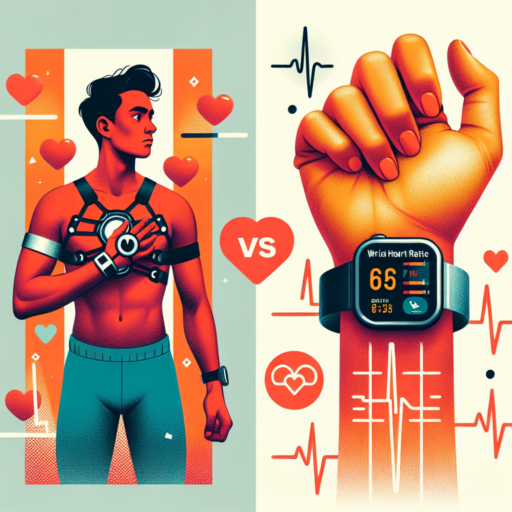Introduction to Chest and Wrist Heart Rate Monitors
Exploring the world of fitness and health tracking, chest and wrist heart rate monitors stand out as crucial tools for athletes, fitness enthusiasts, and health-conscious individuals. These devices offer a window into the body’s cardiovascular performance, providing insights that can guide training, recovery, and general wellness strategies. This introductory overview sheds light on how these monitors work and their distinct advantages.
Chest heart rate monitors, worn snugly around the chest, capture heart rate data directly from the heart’s electrical signals. This method, known as electrocardiography (ECG or EKG), is renowned for its accuracy and responsiveness, making chest monitors the go-to choice for professional athletes and fitness experts. On the other hand, wrist heart rate monitors utilize optical sensors to detect blood flow changes beneath the skin, a technique called photoplethysmography (PPG). These devices have surged in popularity due to their convenience and versatility, seamlessly integrating with everyday wearables like smartwatches and fitness trackers.
The debate between choosing a chest or wrist heart rate monitor often hinges on the user’s specific needs and preferences. Chest straps are celebrated for their precision and reliability during intense workouts, where accurate heart rate data is pivotal. However, they may be viewed as less comfortable for continuous wear. In contrast, wrist monitors offer a comfortable and user-friendly alternative, ideal for day-to-day activity tracking and non-professional sports enthusiasts. Despite potential compromises in accuracy during high-intensity activities, advancements in technology continue to narrow this gap, enhancing the appeal of wrist-based heart rate monitoring.
Accuracy of Chest vs. Wrist Heart Rate Monitors
Understanding the Basics of Heart Rate Monitoring
When assessing the accuracy of heart rate monitors, two popular types are often compared: chest and wrist monitors. Each device employs different technologies and positions on the body to capture heart rate data, influencing their accuracy. Chest straps utilize electrical signals to measure heart rate, closely mirroring the method used in medical ECGs. Conversely, wrist monitors rely on optical sensors that detect blood flow changes, which can be affected by various factors such as movement or skin tone.
Factors Influencing Accuracy
The accuracy of these devices can be influenced by several factors. For chest monitors, a proper fit is crucial; a loose strap might fail to detect the electrical signals accurately. Meanwhile, wrist monitors are susceptible to discrepancies caused by motion artifacts, especially during high-intensity activities. Additionally, the physiological differences among individuals, including skin thickness and tattoo presence, can affect the light absorption, impacting the wrist monitor’s accuracy.
Comparative Insights on Accuracy
Studies have shown that chest strap monitors tend to offer a closer approximation to electrocardiograph readings, making them highly reliable for heart rate monitoring during various activities. In contrast, while improvements have been made in wrist monitor technology, they may still encounter challenges in maintaining accuracy during intense exercises or under conditions that interfere with optical readings. However, for everyday fitness tracking and non-professional usage, wrist monitors provide a convenient and sufficiently accurate measure of heart rate.
No se han encontrado productos.
Comfort and Convenience: Wearing Chest vs. Wrist Monitors
When assessing the difference between wearing chest and wrist monitors, comfort and convenience often emerge as the primary factors influencing an individual’s choice. Chest monitors, traditionally lauded for their accuracy, may present challenges in comfort for some users. The necessity to wear a strap around the chest can sometimes lead to irritation or discomfort during extended periods of exercise.
On the other hand, wrist monitors offer a level of convenience that is hard to match. These devices, which double as watches, provide a seamless way to track fitness without the need for additional accessories. The ease of glancing at one’s wrist to gather data on heart rate, distance, and more, makes wrist monitors a preferred choice for many, especially for those seeking simplicity in their workout routines.
However, it’s important to balance convenience with the need for accuracy. While wrist monitors are improving in technology, some users find that the preciseness of chest monitors, especially regarding heart rate tracking, is unbeatable. The positioning of chest monitors, closer to the heart, allows for data that many athletes find indispensable for training at specific intensities.
Compatibility and Connectivity of Heart Rate Monitors
Understanding the compatibility and connectivity of heart rate monitors is essential for athletes, fitness enthusiasts, and anyone interested in maintaining a healthy lifestyle. These devices have advanced significantly over the years, offering users the ability to track their heart rates with precision. However, the varied market of heart rate monitors presents a challenge in terms of compatibility with different devices and platforms.
Most modern heart rate monitors are designed to be compatible with a wide range of fitness equipment, smartphones, and apps. This is achieved through the use of Bluetooth and ANT+ technologies, which allow for wireless communication between devices. For instance, a heart rate monitor that supports Bluetooth connectivity can easily pair with smartphones and smartwatches, enabling users to synchronize their data with popular fitness apps.
Key Points to Consider for Connectivity
- Bluetooth Compatibility: Check if the heart rate monitor supports Bluetooth Low Energy (BLE) for efficient battery use.
- ANT+ Support: ANT+ allows for connectivity with a variety of fitness equipment and is particularly useful in gym settings.
- App Integration: Ensure that the heart rate monitor is compatible with your preferred fitness and health tracking apps.
When considering a heart rate monitor, it’s also valuable to look into the device’s ability to update firmware over the air. This feature ensures that your device can receive software updates, improving functionality and extending compatibility with newer smartphones and apps over time. By taking these factors into account, users can select a heart rate monitor that not only meets their current needs but is also future-proofed for emerging technology.
Cost Comparison: Is a Chest or Wrist Heart Rate Monitor Better Value?
When it comes to tracking your heart rate, the choice between chest and wrist monitors can significantly affect both your experience and your wallet. Chest straps have long been heralded for their accuracy, often used by athletes and fitness enthusiasts who require precise data to optimize their training regimes. Meanwhile, wrist-worn devices, with their convenience and multifunction capabilities, have surged in popularity among the general fitness community. But which option offers better value for money?
Upfront Costs: Wrist vs. Chest Monitors
Initially, the upfront cost is a crucial point of consideration. Wrist heart rate monitors, especially those integrated into smartwatches, tend to be more expensive than their chest strap counterparts. These devices usually range from moderate to high prices, reflecting their additional features such as text notifications, activity tracking, and GPS functionality. Chest straps, on the other hand, while less multifunctional, focus purely on heart rate tracking, making them more accessible and budget-friendly.
Long-Term Value and Durability
Beyond the purchase price, durability and lifespan are essential factors in determining value. Chest straps generally boast a simpler design and can be more durable over time, potentially offering better long-term value. However, wrist monitors, with regular firmware updates and added features, may provide a better investment for users looking for more than just heart rate readings. It’s also worth noting that wrist devices might require more frequent charging or even band replacements, adding to their long-term costs.
In conclusion, deciding between a chest or wrist heart rate monitor comes down to your specific needs, preferences, and budget. While chest straps might seem like a cost-effective choice initially, the added benefits and functionalities of wrist devices could justify their higher price tag for many users, providing considerable value in the long run.
Durability and Maintenance: What to Expect
Understanding the durability and maintenance requirements of your products is crucial for ensuring their long lifespan and optimal performance. Durability refers to how well a product can withstand wear, pressure, or damage without requiring excessive repairs or replacements. On the other hand, maintenance involves the regular care and repairs that keep the product functioning as expected over time.
Key Factors Influencing Durability
Several factors play a crucial role in determining the durability of a product. Material composition, manufacturing quality, and environmental exposure all contribute to how well a product can resist the test of time and use. For instance, materials like stainless steel and high-density polymers are known for their durability and resistance to corrosion and wear. Identifying these factors can help you make informed decisions about the longevity of a product before purchase.
Effective Maintenance Strategies
To maximize the lifespan of any product, adopting effective maintenance strategies is essential. Regular cleaning, proper storage, and timely repairs are all practices that contribute to a product’s enduring performance. For instance, electronic devices benefit greatly from dusting and software updates, while vehicles require regular oil changes and part inspections. Establishing a routine maintenance schedule can prevent minor issues from escalating into major problems, ensuring the product remains reliable and functional for years to come.
Best Use Cases for Chest and Wrist Heart Rate Monitors
When considering the monitoring of heart rate, two popular methods come to the forefront: chest and wrist heart rate monitors. Each of these tools offers unique benefits tailored to specific activities and user needs. Understanding the best use cases for each can significantly enhance one’s fitness tracking and health monitoring.
For Endurance Athletes: Chest Heart Rate Monitors
Chest heart rate monitors are renowned for their accuracy and reliability. They are particularly beneficial for endurance athletes such as marathon runners, cyclists, and triathletes. These devices work by measuring electrical signals from the heart, providing real-time data that is crucial for athletes looking to optimize their performance and endurance. With the ability to deliver precise heart rate measurements, chest straps are indispensable for training sessions where maintaining specific heart rate zones is key to building stamina and improving cardiovascular strength.
For Daily Fitness Tracking: Wrist Heart Rate Monitors
Wrist heart rate monitors, on the other hand, offer convenience and ease of use, making them ideal for day-to-day fitness tracking. These devices, often incorporated into smartwatches and fitness trackers, use optical sensors to detect blood flow. While they may not match the pinpoint accuracy of chest straps, they provide a great way to monitor general heart rate trends throughout the day. This includes tracking resting heart rate, calorie burn, and even stress levels, making wrist monitors a versatile tool for anyone looking to stay on top of their fitness and health goals.
In addition, wrist heart rate monitors encourage regular interaction and provide insights into overall well-being, allowing users to make informed decisions about their health and fitness routines. Whether it’s during a brisk walk, a yoga session, or a day filled with meetings, these devices offer the flexibility and accessibility needed to monitor heart health in a variety of settings.
Understanding the distinct advantages of chest and wrist heart rate monitors empowers individuals to choose the tool that best fits their lifestyle and fitness objectives. Whether precision and detailed data or convenience and general trends are the priority, there’s a heart rate monitoring solution to meet the needs of every type of user.
Pros and Cons of Chest Heart Rate Monitors
When considering the options for tracking heart rate during physical activities, chest heart rate monitors are a popular choice. Many athletes, from amateur to professional, utilize these devices to optimize their training. However, like any technology, they come with their own set of advantages and drawbacks.
Benefits of Using Chest Heart Rate Monitors
Chest heart rate monitors are known for their accuracy. Compared to other types of heart rate monitors, such as wrist-worn devices, they are generally more reliable for capturing precise heart rate data. This is because they are positioned close to the heart and measure electrical impulses, providing real-time, accurate heart rate readings. Furthermore, they are less likely to be affected by external factors like movement and temperature, which can sometimes skew the readings of wrist-based devices.
Drawbacks of Chest Heart Rate Monitors
Despite their accuracy, chest heart rate monitors are not without their downsides. One common complaint is the comfort issue. Wearing a chest strap during long or intense workout sessions can be intrusive and uncomfortable for some users. Additionally, these devices require direct skin contact to function effectively, which can lead to chafing or irritation over time. Another consideration is the need for regular maintenance, such as washing the strap and replacing batteries, which adds an extra layer of upkeep not required by some other types of heart rate monitors.
Pros and Cons of Wrist Heart Rate Monitors
Wrist heart rate monitors have become increasingly popular among fitness enthusiasts and individuals looking to track their physical activity and health metrics. These convenient gadgets offer a way to monitor your heart rate continuously without the need for chest straps or other more cumbersome equipment. However, like any technology, they come with their own set of advantages and disadvantages.
Advantages of Wrist Heart Rate Monitors
- User-Friendly: One of the most significant advantages is their ease of use. Wrist heart rate monitors are worn just like a watch, making them incredibly accessible and straightforward to operate for daily monitoring.
- Non-Intrusive: Unlike traditional heart rate monitors that require a chest strap, wrist-based monitors offer comfort and convenience, allowing users to wear them all day without discomfort.
- Multifunctionality: Many wrist heart rate monitors come with additional features such as step counting, sleep tracking, and even smartphone notifications, making them a versatile tool for overall wellness.
Disadvantages of Wrist Heart Rate Monitors
- Accuracy Issues: Despite technological advancements, wrist heart rate monitors can sometimes provide less accurate readings than their chest strap counterparts, especially during high-intensity activities.
- Dependency on Skin Contact: These devices rely on contact with your skin to obtain readings, which means that they can be affected by factors such as skin temperature, tattoo coverings, and even hair on your wrists.
- Price: High-end models of wrist heart rate monitors come with a steep price tag, making them less accessible for individuals on a tight budget.
Conclusion: Choosing the Right Heart Rate Monitor for Your Needs
When selecting the ideal heart rate monitor for your fitness journey, there are several facets to consider to ensure it aligns perfectly with your goals and lifestyle. The variety of options available can sometimes feel overwhelming, but understanding the key features that meet your specific requirements can significantly narrow down the choices. Whether you’re a professional athlete, a fitness enthusiast, or someone looking to monitor their heart health, identifying your primary need is the first step towards making an informed decision.
Key Features to Look For
- Accuracy: The precision of heart rate data is paramount. Look for monitors that are renowned for their reliability and accuracy.
- Comfort and Fit: Whether opting for a chest strap or a wrist-based monitor, ensuring a comfortable fit is crucial for continual use and accurate readings.
- Connectivity: Consider devices that easily sync with your smartphone or fitness apps to track your progress comprehensively.
- Battery Life: A long-lasting battery is essential for uninterrupted training sessions and daily use without the constant need for recharging.
By focusing on these critical elements, you can simplify the selection process and choose a heart rate monitor that not only complements your fitness regime but also enhances your understanding of your physical health. Remember, the best heart rate monitor is the one that you will consistently use and which provides data that you can trust and act upon. As technology advances, keep an eye out for new features and improvements that could further assist in achieving your health and fitness objectives.



